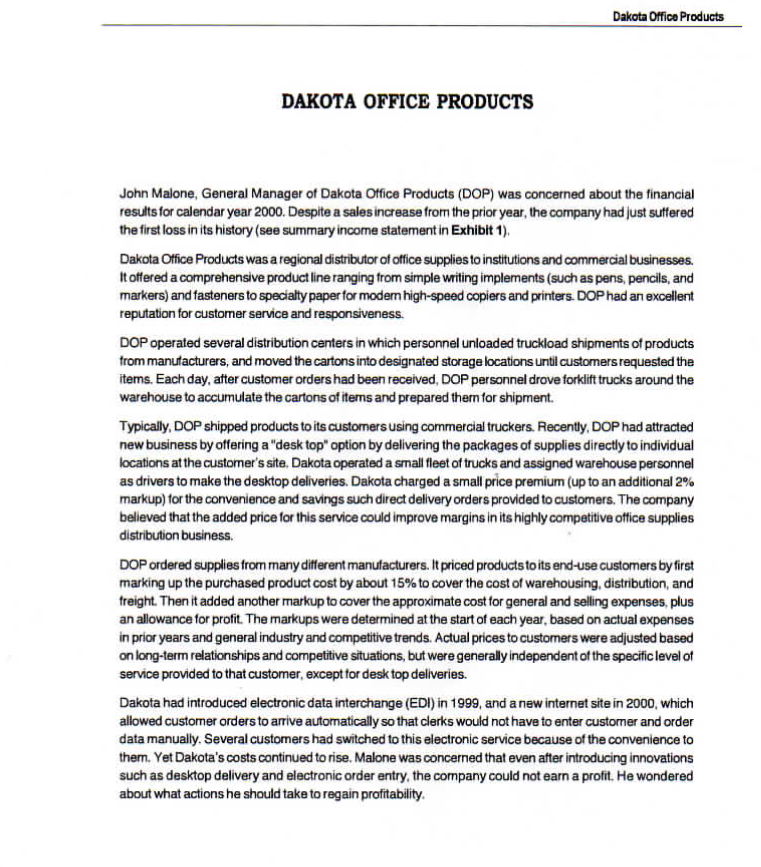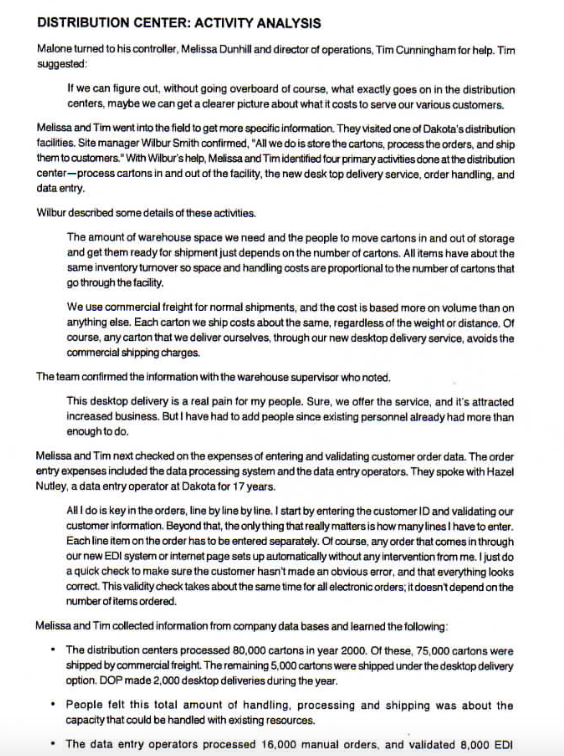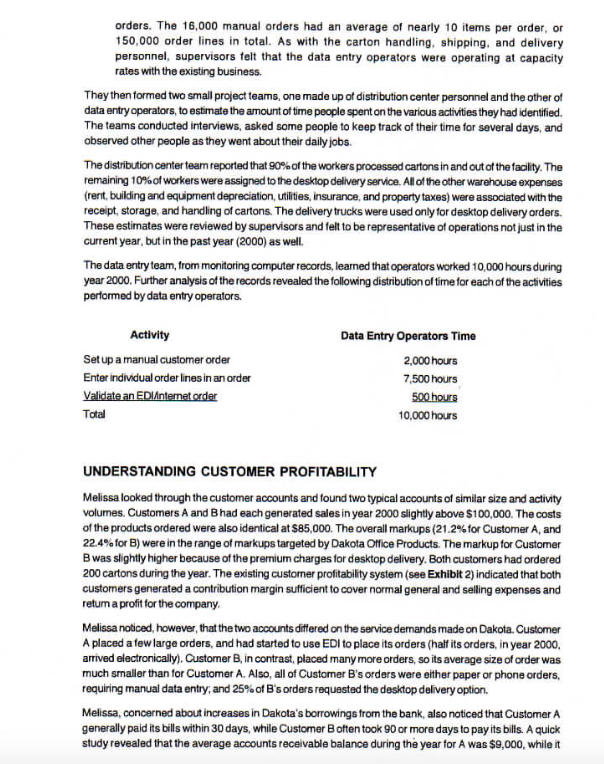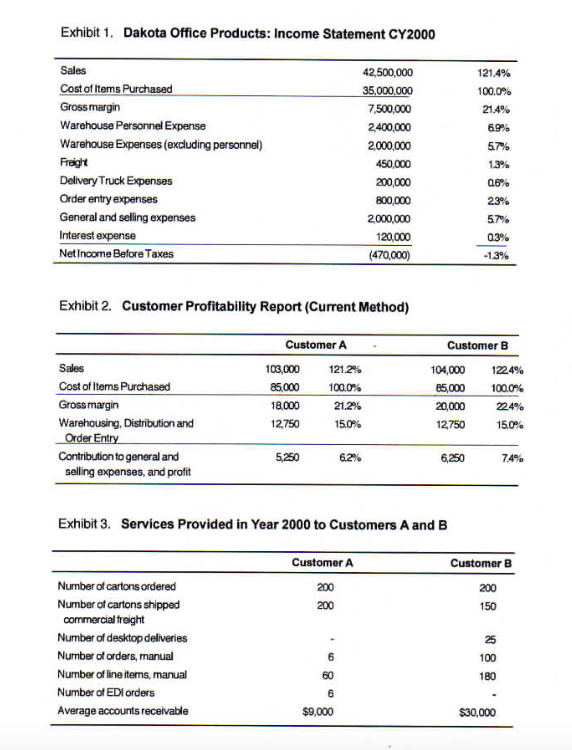Summary:
Please analyze the case Dakota Office Products by identifying the activities, cost drivers and then analyzing customers A and B profitability.
Assess Dakota's current use of a single overhead application rate.
Review Dakota's allocation of overheads costs under ABC, Activity Based Costing.
Under ABC sub-activities and respective cost drivers identified in the case consist of: Processing boxes, driven by the number of boxes, Desktop delivery, driven by deliveries, Manual ordering, driven by manual orders, Manuel processing of line items, driven by volume of items, Commercial freight, driven by the number of cartons shipped, and EDI activity, driven by the number of orders.
Use the revised activity / cost drivers to allocate among customer A and customer B Dakotas overheads (Warehouse personnel expense, Warehouse non-personnel expenses, Freight, Delivery truck expense and Order entry expense), according to customers individual number of cartons ordered, number of cartons shipped by commercial freight, number of desktop deliveries, number of manual orders, number of manual line items and number of EDI orders.
In addition to above overheads, deduct from customers sales respective costs of items purchased and average cost of accounts receivable (10% of outstanding balance) to identify each customer's profitability.





Dakota Office Products DAKOTA OFFICE PRODUCTS John Malone, General Manager of Dakota Office Products (DOP) was concerned about the financial results for calendar year 2000. Despite a sales increase from the prior year, the company had just suffered the first loss in its history (see summary income statement in Exhibit 1) Dakota Office Products was a regional distributor of office supplies to institutions and commercial businesses, It offered a comprehensive product lineranging from simple writing implements (such as pens, pencils, and markers) and fasteners to specialty paper for modern high-speed copiers and printers. DOP had an excellent reputation for customer service and responsiveness. DOP operated several distribution centers in which personnel unloaded truckload shipments of products trom manufacturers, and moved the cartons into designated storage locations until customers requested the items. Each day, after customer orders had been received, DOP personnel drove forklift trucks around the warehouse to accumulate the cartons of items and prepared thern for shipment. Typically, DOP shipped products to its customers using commercial truckers. Recently, DOP had attracted new business by offering a "desktop" option by delivering the packages of supplies directly to individual locations at the customer's site. Dakota operated a small fleet of trucks and assigned warehouse personnel as drivers to make the desktop deliveries. Dakota charged a small price premium (up to an additional 2% markup) for the convenience and savings such direct delivery orders provided to customers. The company believed that the added price for this service could improve margins in its highly competitive office supplies distribution business DOP ordered supplies from many different manufacturers. It priced products to its end-use customers by first marking up the purchased product cost by about 15% to cover the cost of warehousing, distribution, and freight. Then it added another markup to cover the approximate cost for general and selling expenses, plus an allowance for profit. The markups were determined at the start of each year, based on actual expenses in prior years and general industry and competitive trends. Actual prices to customers were adjusted based on long-term relationships and competitive situations, but were generally independent of the specific level of service provided to that customer, except for desk top deliveries. Dakota had introduced electronic data interchange (EDI) in 1999, and a new internet site in 2000, which allowed customer orders to arrive automatically so that clerks would not have to enter customer and order data manually. Several customers had switched to this electronic service because of the convenience to them. Yet Dakota's costs continued to rise. Malone was concerned that even after introducing innovations such as desktop delivery and electronic order entry, the company could not earn a profit. He wondered about what actions he should take to regain profitability, DISTRIBUTION CENTER: ACTIVITY ANALYSIS Malone turned to his controller, Melissa Dunhill and director of operations, Tim Cunningham for help. Tim suggested If we can figure out without going overboard of course, what exactly goes on in the distribution centers, maybe we can get a clearer picture about what it costs to serve our various customers. Melissa and Tim went into the field to get more specific information They visited one of Dakota's distribution facilities. Site manager Wibur Smith confirmed, "Al we do is store the cartons, process the orders, and ship them to customers." With Wilbur's help. Melissa and Timidertified four primary activities done at the distribution center-process cartons in and out of the facility, the new desktop delivery service, order handling, and data entry Wilbur described some details of these activities. The amount of warehouse space we need and the people to move cartons in and out of storage and get them ready for shipment just depends on the number of cartons. All items have about the same inventory turnover so space and handling costs are proportional to the number of cartons that go through the facility. We use commercial freight for normal shipments, and the cost is based more on volume than on anything else. Each carton we ship costs about the same, regardless of the weight or distance. Of course, any carton that we deliver ourselves, through our new desktop delivery service, avoids the commercial shipping charges. The team confirmed the information with the warehouse supervisor who noted. This desktop delivery is a real pain for my people. Sure, we offer the service, and it's attracted Increased business. But I have had to add people since existing personnel already had more than enough to do. Melissa and Tim next checked on the expenses of entering and validating customer order data. The order entry expenses included the data processing system and the data entry operators. They spoke with Hazel Nutley, a data entry operator at Dakota for 17 years. All do is key in the orders, line by line by line. I start by entering the customer ID and validating our customer information. Beyond that, the only thing that really matters is how many lines I have to enter Each line item on the order has to be entered separately. Of course, any order that comes in through our new EDI system or internet page sets up automatically without any intervention from me. I just do a quick check to make sure the customer hasn't made an obvious error, and that everything looks correct. This validity check takes about the same time for all electronic orders: it doesnt depend on the number of items ordered. Melissa and Tim collected information from company databases and learned the following: The distribution centers processed 80,000 cartons in year 2000. Of these, 75,000 cartons were shipped by commercial freight. The remaining 5,000 cartons were shipped under the desktop delivery option DOP made 2.000 desktop deliveries during the year. People felt this total amount of handling, processing and shipping was about the capacity that could be handled with existing resources. The data entry operators processed 16,000 manual orders, and validated 8,000 EDI orders. The 16,000 manual orders had an average of nearly 10 items per order, or 150,000 order lines in total. As with the carton handling, shipping, and delivery personnel, supervisors felt that the data entry operators were operating at capacity rates with the existing business. They then formed two small project teams, one made up of distribution center personnel and the other of data entry operators, to estimate the amount of time people spent on the various activities they had identified. The teams conducted interviews, asked some people to keep track of their time for several days, and observed other people as they went about their daily jobs. The distribution center team reported that 90% of the workers processed cartons in and out of the facility. The remaining 10% of workers were assigned to the desktop delivery service. All of the other warehouse expenses (rent, building and equipment depreciation, utilities, insurance and property taxes) were associated with the receipt, storage, and handling of cartons. The delivery trucks were used only for desktop delivery orders. These estimates were reviewed by supervisors and felt to be representative of operations not just in the current year, but in the past year (2000) as well The data entry team, from monitoring computer records, learned that operators worked 10,000 hours during year 2000. Further analysis of the records revealed the following distribution of time for each of the activities performed by data entry operators. Activity Set up a manual customer order Enter individual order lines in an order Validate an EDIAntemet order Total Data Entry Operators Time 2,000 hours 7,500 hours 500.hours 10,000 hours UNDERSTANDING CUSTOMER PROFITABILITY Melissa looked through the customer accounts and found two typical accounts of similar size and activity volumes. Customers A and Bhad each generated sales in year 2000 slightly above $100,000. The costs of the products ordered were also identical at $85,000. The overall markups (21.2% for Customer A, and 224% for B) were in the range of markups targeted by Dakota Office Products. The markup for Customer Bwas slightly higher because of the premium charges for desktop delivery. Both customers had ordered 200 cartons during the year. The existing customer profitability system (see Exhibit 2) indicated that both customers generated a contribution margin sufficient to cover normal general and selling expenses and return a profit for the company, Melissa noticed, however, that the two accounts differed on the service demands made on Dakota. Customer A placed a few large orders, and had started to use ED to place its orders (half its orders, in year 2000, arrived electronically). Customer B, in contrast, placed many more orders, so its average size of order was much smaller than for Customer A. Also, all of Customer B's orders were either paper or phone orders, requiring manual data entry, and 25% of B'sorders requested the desktop delivery option. Melissa, concerned about increases in Dakota's borrowings from the bank. also noticed that Customer A generally paid its bills within 30 days, while Customer often took 90 or more days to pay its bills. A quick study revealed that the average accounts receivable balance during the year for A was $9,000, while it was $30,000 for B. With Dakota paying interest of 10% per year on its working capital line of credit, Melissa thought this difference might be significant Exhibit 3 shows Melissa's summary of the actual ordering, delivery and payment statistics for the two customers. She believed she was now ready to assess the actual profitability of customers, and make recommendations about how to reverse Dakota's recent profit slide. Exhibit 1. Dakota Office Products: Income Statement CY2000 121.4% 100.0% Sales Cost of items Purchased Gross margin Warehouse Personnel Expense Warehouse Expenses (excluding personnel) Freight Delivery Truck Expenses Order entry expenses General and selling expenses Interest expense Net Income Before Taxes 42,500,000 35,000,000 7,500,000 2,400,000 2,000,000 450,000 200,000 800,000 2,000,000 120,000 (470,000) Exhibit 2. Customer Profitability Report (Current Method) Customer A Customer B Sales Cost of items Purchased Gross margin Warehousing, Distribution and Order Entry Contribution to general and selling expenses, and profit 103,000 85.000 18,000 12750 121.2% 100.0% 21.2% 15.0% 104,000 85,000 20,000 12750 1224% 100.0% 24% 150%. 5250 6250 Exhibit 3. Services Provided in Year 2000 to Customers A and B Customer A Customer B Number of cartons ordered Number of cartons shipped commercial freight Number of desktop deliveries Number of orders, manual Number of line items, manual Number of EDI orders Average accounts receivable $9,000 $30,000 Dakota Office Products DAKOTA OFFICE PRODUCTS John Malone, General Manager of Dakota Office Products (DOP) was concerned about the financial results for calendar year 2000. Despite a sales increase from the prior year, the company had just suffered the first loss in its history (see summary income statement in Exhibit 1) Dakota Office Products was a regional distributor of office supplies to institutions and commercial businesses, It offered a comprehensive product lineranging from simple writing implements (such as pens, pencils, and markers) and fasteners to specialty paper for modern high-speed copiers and printers. DOP had an excellent reputation for customer service and responsiveness. DOP operated several distribution centers in which personnel unloaded truckload shipments of products trom manufacturers, and moved the cartons into designated storage locations until customers requested the items. Each day, after customer orders had been received, DOP personnel drove forklift trucks around the warehouse to accumulate the cartons of items and prepared thern for shipment. Typically, DOP shipped products to its customers using commercial truckers. Recently, DOP had attracted new business by offering a "desktop" option by delivering the packages of supplies directly to individual locations at the customer's site. Dakota operated a small fleet of trucks and assigned warehouse personnel as drivers to make the desktop deliveries. Dakota charged a small price premium (up to an additional 2% markup) for the convenience and savings such direct delivery orders provided to customers. The company believed that the added price for this service could improve margins in its highly competitive office supplies distribution business DOP ordered supplies from many different manufacturers. It priced products to its end-use customers by first marking up the purchased product cost by about 15% to cover the cost of warehousing, distribution, and freight. Then it added another markup to cover the approximate cost for general and selling expenses, plus an allowance for profit. The markups were determined at the start of each year, based on actual expenses in prior years and general industry and competitive trends. Actual prices to customers were adjusted based on long-term relationships and competitive situations, but were generally independent of the specific level of service provided to that customer, except for desk top deliveries. Dakota had introduced electronic data interchange (EDI) in 1999, and a new internet site in 2000, which allowed customer orders to arrive automatically so that clerks would not have to enter customer and order data manually. Several customers had switched to this electronic service because of the convenience to them. Yet Dakota's costs continued to rise. Malone was concerned that even after introducing innovations such as desktop delivery and electronic order entry, the company could not earn a profit. He wondered about what actions he should take to regain profitability, DISTRIBUTION CENTER: ACTIVITY ANALYSIS Malone turned to his controller, Melissa Dunhill and director of operations, Tim Cunningham for help. Tim suggested If we can figure out without going overboard of course, what exactly goes on in the distribution centers, maybe we can get a clearer picture about what it costs to serve our various customers. Melissa and Tim went into the field to get more specific information They visited one of Dakota's distribution facilities. Site manager Wibur Smith confirmed, "Al we do is store the cartons, process the orders, and ship them to customers." With Wilbur's help. Melissa and Timidertified four primary activities done at the distribution center-process cartons in and out of the facility, the new desktop delivery service, order handling, and data entry Wilbur described some details of these activities. The amount of warehouse space we need and the people to move cartons in and out of storage and get them ready for shipment just depends on the number of cartons. All items have about the same inventory turnover so space and handling costs are proportional to the number of cartons that go through the facility. We use commercial freight for normal shipments, and the cost is based more on volume than on anything else. Each carton we ship costs about the same, regardless of the weight or distance. Of course, any carton that we deliver ourselves, through our new desktop delivery service, avoids the commercial shipping charges. The team confirmed the information with the warehouse supervisor who noted. This desktop delivery is a real pain for my people. Sure, we offer the service, and it's attracted Increased business. But I have had to add people since existing personnel already had more than enough to do. Melissa and Tim next checked on the expenses of entering and validating customer order data. The order entry expenses included the data processing system and the data entry operators. They spoke with Hazel Nutley, a data entry operator at Dakota for 17 years. All do is key in the orders, line by line by line. I start by entering the customer ID and validating our customer information. Beyond that, the only thing that really matters is how many lines I have to enter Each line item on the order has to be entered separately. Of course, any order that comes in through our new EDI system or internet page sets up automatically without any intervention from me. I just do a quick check to make sure the customer hasn't made an obvious error, and that everything looks correct. This validity check takes about the same time for all electronic orders: it doesnt depend on the number of items ordered. Melissa and Tim collected information from company databases and learned the following: The distribution centers processed 80,000 cartons in year 2000. Of these, 75,000 cartons were shipped by commercial freight. The remaining 5,000 cartons were shipped under the desktop delivery option DOP made 2.000 desktop deliveries during the year. People felt this total amount of handling, processing and shipping was about the capacity that could be handled with existing resources. The data entry operators processed 16,000 manual orders, and validated 8,000 EDI orders. The 16,000 manual orders had an average of nearly 10 items per order, or 150,000 order lines in total. As with the carton handling, shipping, and delivery personnel, supervisors felt that the data entry operators were operating at capacity rates with the existing business. They then formed two small project teams, one made up of distribution center personnel and the other of data entry operators, to estimate the amount of time people spent on the various activities they had identified. The teams conducted interviews, asked some people to keep track of their time for several days, and observed other people as they went about their daily jobs. The distribution center team reported that 90% of the workers processed cartons in and out of the facility. The remaining 10% of workers were assigned to the desktop delivery service. All of the other warehouse expenses (rent, building and equipment depreciation, utilities, insurance and property taxes) were associated with the receipt, storage, and handling of cartons. The delivery trucks were used only for desktop delivery orders. These estimates were reviewed by supervisors and felt to be representative of operations not just in the current year, but in the past year (2000) as well The data entry team, from monitoring computer records, learned that operators worked 10,000 hours during year 2000. Further analysis of the records revealed the following distribution of time for each of the activities performed by data entry operators. Activity Set up a manual customer order Enter individual order lines in an order Validate an EDIAntemet order Total Data Entry Operators Time 2,000 hours 7,500 hours 500.hours 10,000 hours UNDERSTANDING CUSTOMER PROFITABILITY Melissa looked through the customer accounts and found two typical accounts of similar size and activity volumes. Customers A and Bhad each generated sales in year 2000 slightly above $100,000. The costs of the products ordered were also identical at $85,000. The overall markups (21.2% for Customer A, and 224% for B) were in the range of markups targeted by Dakota Office Products. The markup for Customer Bwas slightly higher because of the premium charges for desktop delivery. Both customers had ordered 200 cartons during the year. The existing customer profitability system (see Exhibit 2) indicated that both customers generated a contribution margin sufficient to cover normal general and selling expenses and return a profit for the company, Melissa noticed, however, that the two accounts differed on the service demands made on Dakota. Customer A placed a few large orders, and had started to use ED to place its orders (half its orders, in year 2000, arrived electronically). Customer B, in contrast, placed many more orders, so its average size of order was much smaller than for Customer A. Also, all of Customer B's orders were either paper or phone orders, requiring manual data entry, and 25% of B'sorders requested the desktop delivery option. Melissa, concerned about increases in Dakota's borrowings from the bank. also noticed that Customer A generally paid its bills within 30 days, while Customer often took 90 or more days to pay its bills. A quick study revealed that the average accounts receivable balance during the year for A was $9,000, while it was $30,000 for B. With Dakota paying interest of 10% per year on its working capital line of credit, Melissa thought this difference might be significant Exhibit 3 shows Melissa's summary of the actual ordering, delivery and payment statistics for the two customers. She believed she was now ready to assess the actual profitability of customers, and make recommendations about how to reverse Dakota's recent profit slide. Exhibit 1. Dakota Office Products: Income Statement CY2000 121.4% 100.0% Sales Cost of items Purchased Gross margin Warehouse Personnel Expense Warehouse Expenses (excluding personnel) Freight Delivery Truck Expenses Order entry expenses General and selling expenses Interest expense Net Income Before Taxes 42,500,000 35,000,000 7,500,000 2,400,000 2,000,000 450,000 200,000 800,000 2,000,000 120,000 (470,000) Exhibit 2. Customer Profitability Report (Current Method) Customer A Customer B Sales Cost of items Purchased Gross margin Warehousing, Distribution and Order Entry Contribution to general and selling expenses, and profit 103,000 85.000 18,000 12750 121.2% 100.0% 21.2% 15.0% 104,000 85,000 20,000 12750 1224% 100.0% 24% 150%. 5250 6250 Exhibit 3. Services Provided in Year 2000 to Customers A and B Customer A Customer B Number of cartons ordered Number of cartons shipped commercial freight Number of desktop deliveries Number of orders, manual Number of line items, manual Number of EDI orders Average accounts receivable $9,000 $30,000











